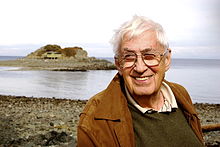CS Holling
Crawford Stanley "Buzz" Holling , often just CS Holling ( December 6, 1930 in Theresa , New York - August 16, 2019 in Nanaimo , British Columbia ), was an eminent Canadian ecologist .
Life
Holling received his PhD from the University of British Columbia in 1957 . He worked as a scientist for the Canadian Forest Service . This was followed by an appointment as a professor at the University of British Columbia. At the end of the 1970s he became head of the International Institute for Applied Systems Analysis in Austria. In the early 1980s, he returned to the University of British Columbia and then moved to the University of Florida . He lived long in Cedar Key , Florida , and passed his old age in Nanaimo , British Columbia , where he died in 2019.
Holling was the founder of the Resilience Alliance , an association of scientists in numerous countries. His theories formed the basis for the Stockholm Resilience Center at Stockholm University .
Holling has received many awards for his work, u. a. with the Order of Canada (Officer) and the election to the Royal Society of Canada . The jury for the Volvo Environment Prize justified the awarding of Holling in 2008 with the following words: “Crawford (Buzz) Holling is one of the most creative and influential ecologists of our time. His integrative thinking has shed new light on the growth, breakdown and renewal of coupled socio-ecological systems . "
Act
Holling was considered one of the leading ecologists worldwide. He made important contributions to populations in predator-prey relationships , to ecological resilience , to panarchies, and to adaptive management .
Holling recognized that the definition of resilience used by engineers in the sense of stability and fail-safe design , which he called technical resilience (engineering resilience) , cannot simply be transferred to ecological systems, as it is in ecology was common at the time. He therefore defined the resilience of ecological systems in 1973 instead as "a measure of the persistence of systems [ie ecosystems, note] and their ability to absorb changes and disturbances while still maintaining the same relationships between populations or state variables ." no longer about keeping the ratio of certain animal or plant species in an ecosystem (e.g. forest) stable, but about ensuring the adaptability and functionality of the system even in the event of disruptions (e.g. forest fires). In contrast to technical resilience, his definition of ecological resilience was aimed at continuity, change, unpredictability and safe failure (safe-fail design) and largely asserted itself in ecology.
In 1986 he introduced the model of adaptive circuits (adaptive cycle) into the ecological literature, the later on many socio-ecological systems has been applied. The model describes how an ecosystem grows over a long period of time and then apparently remains in a stable state, but the resources available in the system (e.g. nutrients) then suddenly reorganize (e.g. due to a forest fire) and thus something New can arise. Holling once described the adaptive cycle as follows: “It's like applying two separate objectives, but one after the other. The first maximizes production and accumulation; the second maximizes invention and rearrangement. The two objectives cannot be maximized at the same time, but only occur one after the other. And success in achieving a goal inexorably creates the conditions for its opposite. The adaptive cycle therefore comprises two opposites: growth and stability on the one hand, change and diversity on the other. ”Together with Lance H. Gunderson , he later introduced the term panarchy into ecological literature, which does justice to the fact that several adaptive cycles are based on different temporal and spatial levels work and influence each other.
Holling's theory of resilience, adaptive cycles and panarchies is widely used today to understand crises . Holling once described this using the example of the climate crisis : “We are currently experiencing an outstanding example of an emerging crisis with climate change. Our ability to deal with this will of course depend on how we can limit greenhouse gas emissions, but equally important is the ability to adapt and understand how ecosystems develop and change. "
Selected publications
- CS Holling and Lance H. Gunderson (2002). Panarchy: Understanding Transformations in Human and Natural Systems. Washington, Island Press.
Web links
Individual evidence
- ↑ a b c d e f g h Institute for the Oceans and Fisheries (2019). In memoriam: Crawford Stanley (Buzz) Holling, OC FRSC. IOFNews. https://oceans.ubc.ca/2019/09/13/in-memoriam-buzz-holling/ Access date: September 7, 2020
- ↑ a b c Volvo Environment Prize (2008). Crawford "Buzz" Holling. http://www.environment-prize.com/laureates/by-year/2008/crawford-buzz-holling/ Accessed September 7, 2020
- ↑ CS Holling (1973). Resilience and stability of ecological systems. Annual Review of Ecology and Systematics 4, 1-23. In the English original: “Measure of the persistence of systems and of their ability to absorb change and disturbance and still maintain the same relationships between populations or state variables” (p. 14).
- ↑ CS Holling (1996). Engineering resilience versus ecological resilience. In: Schulze, P. (Ed.), Engineering Within Ecological Constraints. National Academy Press, Washington, DC, pp. 31-44.
- ↑ CS Holling (1986). Resilience of ecosystems; local surprise and global change. In: WC Clark and RW Munn (eds.). Sustainable development of the biosphere. Cambridge, UK, Cambridge University Press. 292-317.
- ↑ CS Holling (2001). Understanding the complexity of economic, ecological, and social systems. Ecosystems 4, 390-405.
- ^ LH Gunderson and CS Holling (2002). Panarchy. Understanding Transformations in Human and Natural Systems. ISBN 1-55963-856-7
| personal data | |
|---|---|
| SURNAME | Holling, CS |
| ALTERNATIVE NAMES | Holling, Crawford Stanley (full name); Holling, Buzz (nickname) |
| BRIEF DESCRIPTION | Canadian ecologist |
| DATE OF BIRTH | December 6, 1930 |
| PLACE OF BIRTH | Theresa , New York |
| DATE OF DEATH | 16th August 2019 |
| Place of death | Nanaimo , British Columbia |
